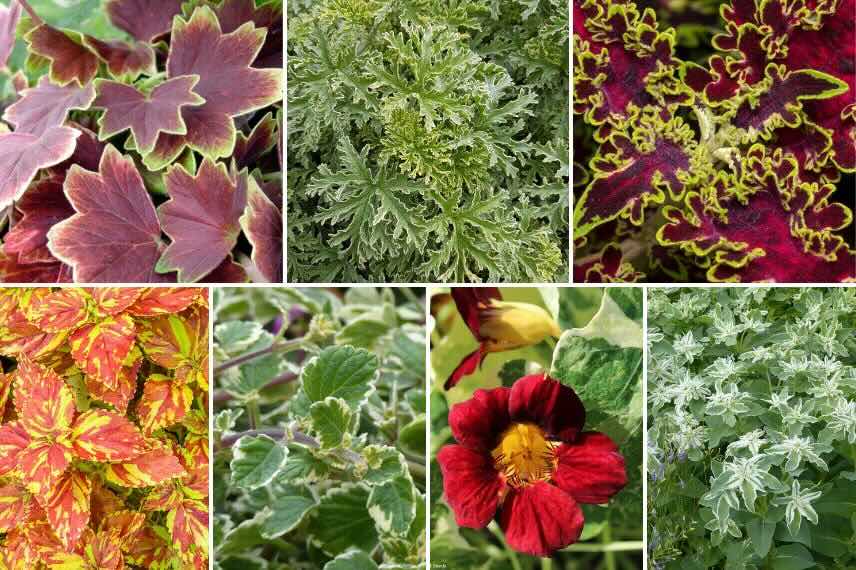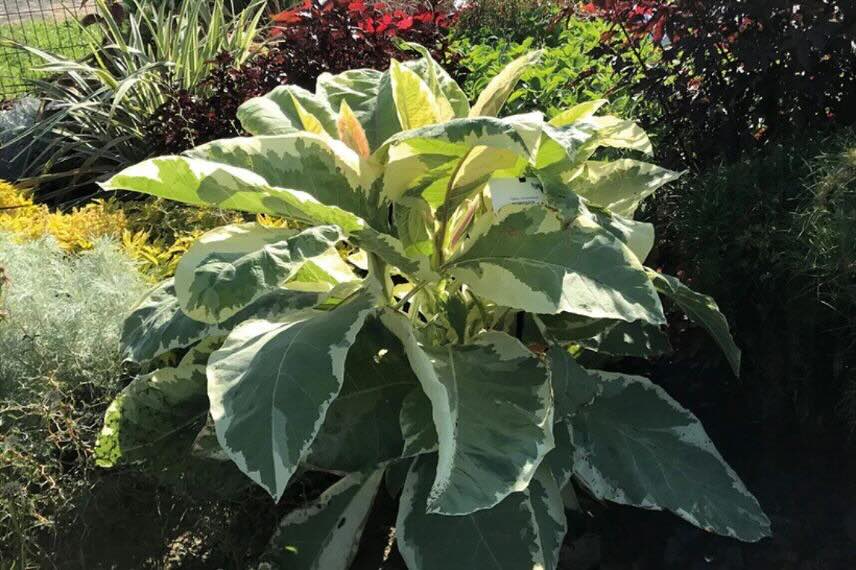
Colours and Contrasts: The Most Beautiful Variegated Annuals
Colourful plants all season long
Contents
Variegated foliage, marbled, cream-edged or with colourful patterns, brings dynamism to a plant composition. Unlike fleeting flowerings, it ensures a lively and contrasting display from spring to autumn. In pots, flower beds or planters, variegated annual plants bring light, rhythm and sometimes even a touch of whimsy. Easy to grow, they allow you to experiment with new atmospheres each season, from romantic gardens to tropical displays. Discover in this article a selection of original varieties, pairing advice and simple tips to showcase them and care for them.
Why choose variegated annuals?
Variegated foliage is a true visual signature in a garden or composition. Speckled, marbled, marginate or veined with white, cream, pink or purple, it catches the eye and adds a touch of whimsy without waiting for flowering. In a plant scene, it plays the role of punctuation, light or even strong contrast. And that’s precisely what makes it so charming.
A touch of light
Light variegations, often white or cream, act like touches of light at the heart of a flowerbed or in a container. They brighten up dull or shady corners and create depth in a dense composition. They are effective for visually lightening a scene composed of dark foliage or intense flowering.
Dynamic contrasts
Variegated foliage naturally creates contrast, sometimes within itself (as with caladiums), sometimes with surrounding plants. They are perfect for highlighting other plants, structuring a flowerbed or simply adding rhythm to a scene. They work equally well in exotic or classic styles.
A touch of originality
More unexpected than plain foliage, variegated foliage offers a great variety of patterns and colours. Each variety has its own design, almost like a natural work of art. It’s an excellent way to add a personal signature to your containers or garden, changing each year according to your mood or desired atmosphere.
Constant decorative presence
Unlike flowers, decorative foliage is present from the beginning to the end of the season. They don’t go through dull or faded phases, and their impact remains constant. This is a major asset for gardeners who want harmonious compositions from spring to autumn.

The variegated foliage of Hypoestes ‘Hippo White’ is very luminous
Read also
10 Easy Annual Flowers to SowSelection of variegated annual plants
Variegated Coleus (Solenostemon scutellarioides)
Coleus are renowned for their variegated leaves in diverse colours and patterns. Here are some remarkable varieties:
- Coleus ‘FlameThrower Chipotle’ : This compact variety forms a clump of burgundy leaves edged with acid green, offering a striking contrast. Ideal for containers or shaded beds.
- Coleus ‘Limewire’ : With purple-brown foliage margined in bright green, this coleus adds an exotic touch to compositions. Its upright habit suits borders and containers.
- Coleus ‘Golden Freckles’ : Its rounded leaves are marbled with red then orange, creating a warm effect. This variety thrives in partial shade.
Variegated Pelargoniums or Geraniums
Pelargoniums, often called “florist’s geraniums”, stand out for their abundant flowering and sometimes variegated foliage:
- Zonal Geranium ‘Vancouver’ : Cream-white edged green foliage, slightly quilted, bringing brightness to summer containers. Flowers pink or red depending on conditions.
- Scented Pelargonium ‘Lady Plymouth’ : A variety with finely cut, grey-green foliage margined in white, delightfully mint-scented. Ideal in planters or pots to enjoy its fragrance when touched.
Variegated Caladiums
These are not annuals but bulbs replanted yearly, giving them the same cycle as annuals. Loved for their large heart-shaped leaves, caladiums offer spectacular variegation:
- Caladium ‘Aaron’ : Features pearly white foliage edged with dark green, bringing luminosity to shaded spaces. Perfect in pots or beds.
- Caladium ‘White Christmas’ : Its large white leaves veined with dark green confer refined elegance. Grow indoors or outdoors, sheltered from direct sun.
Other Variegated Annuals
Complementing the above genera, here are some remarkable annuals for their decorative foliage:
- Dwarf Nasturtium ‘Velvet Troika’ : This compact variety displays variegated green and cream foliage, enhanced by velvety red flowers. Ideal for borders or containers.
- Euphorbia marginata ‘Kilimanjaro’ : This annual spurge offers green foliage margined in white, adding a graphic, luminous touch to sunny beds.
- Nicotiana tomentosa ‘Variegata’ : This ornamental tobacco variety stands out with its large, downy variegated green and white foliage and fragrant white tubular flowers. Perfect as a backdrop in beds.
- Plectranthus coleoides ‘Variegatus’ : Green foliage edged with cream, slightly toothed, often aromatic when crushed. Its trailing habit makes it excellent for hanging baskets, planters and container edges. Prefers bright spots without direct sun.
- Hypoestes phyllostachya : This compact annual offers speckled foliage in pink, white or red on a green background, depending on the variety. It enjoys partial shade and is often grown indoors too. Perfect for mixed containers or adding a graphic touch to borders. See for example the Hippo series with ‘Hippo White’ and ‘Hippo Pink’ among others.

Clockwise: Zonal Geranium ‘Vancouver’ and ‘Lady Plymouth’, Coleus ‘Limewire’, Euphorbia marginata ‘Kilimanjaro’, Nasturtium ‘Velvet Troika’, Plectranthus coleoides ‘Variegatus’, Coleus ‘Golden Freckles’
Successfully incorporating variegated annuals into your plant arrangements
Rich in patterns and contrasts, variegated leaves require a bit of finesse to integrate harmoniously. When used judiciously, they become true assets for structuring, brightening, or energising a plant display, whether in pots, flower beds, or hanging baskets.
Creating a focal point
Variegated foliage naturally draws the eye. It can therefore serve as a visual anchor in a container or flower bed. A caladium with large white leaves veined in green, for example, will instantly set the scene and act as a reference point in a composition. It’s important not to overwhelm it with too many other patterns so it retains its full expressive power.
Playing with contrasts
Pairing variegated foliage with plain leaves is often a good strategy. This highlights the patterns without weighing down the overall effect. A coleus with marbled leaves will pair beautifully with a bright green ipomoea or a silver plectranthus. The contrast can also be in textures or shapes: matte and glossy, dentate and smooth, trailing and upright.
Brightening shady areas
Variegated leaves are particularly useful for illuminating partially shaded spots, where dark green foliage often dominates. A hypoestes speckled with pink or a Plectranthus coleoides marginate with white adds light and prevents a heavy, dark effect.
Using moderation
Variegation is a strong visual effect. It’s often best to limit yourself to one or two variegated varieties per display to avoid overload. Too many different patterns can make a flower bed hard to read or a container look messy. It’s better to balance the effects and leave space for each plant to “breathe.”
Making the most of habit and structure
A plant’s habit can also guide its use. Trailing variegated foliage, like that of Plectranthus coleoides ‘Variegatus’, is especially suited to hanging baskets and planter edges. Conversely, more upright foliage, like that of ornamental tobacco, adds height and verticality to a composition.

For a dynamic garden, mix perennials and annuals, foliage colours and varied habits (here Nicotiana ‘Variegata’
Growing and Care Tips
Variegated annual plants are generally easy to care for. However, to maintain the vibrancy of their patterns and their beautiful appearance, a few simple gestures can make all the difference.
The ideal exposure for variegated foliage
Very light foliage, white or cream, is more sensitive to full sun. It can scorch if exposed during the hottest hours, especially in pots. Filtered light (partial shade) is often ideal for preserving colour intensity without risking fading. Coleus, caladiums and hypoestes, for example, generally prefer a spot sheltered from direct sunlight.
Light, well-drained soil
Most annual plants thrive in loose, well-draining and cool soil. A universal potting mix lightened with some sand or perlite works well in pots. In the ground, take care to avoid excess moisture, especially for species with tender or downy foliage.
Regular but moderate watering
Particularly for pot-grown plants, consistent watering is essential, especially during hot periods. The substrate should remain slightly cool without becoming waterlogged. Excess water can lead to dull foliage and encourage diseases.
- Subscribe!
- Contents































Comments